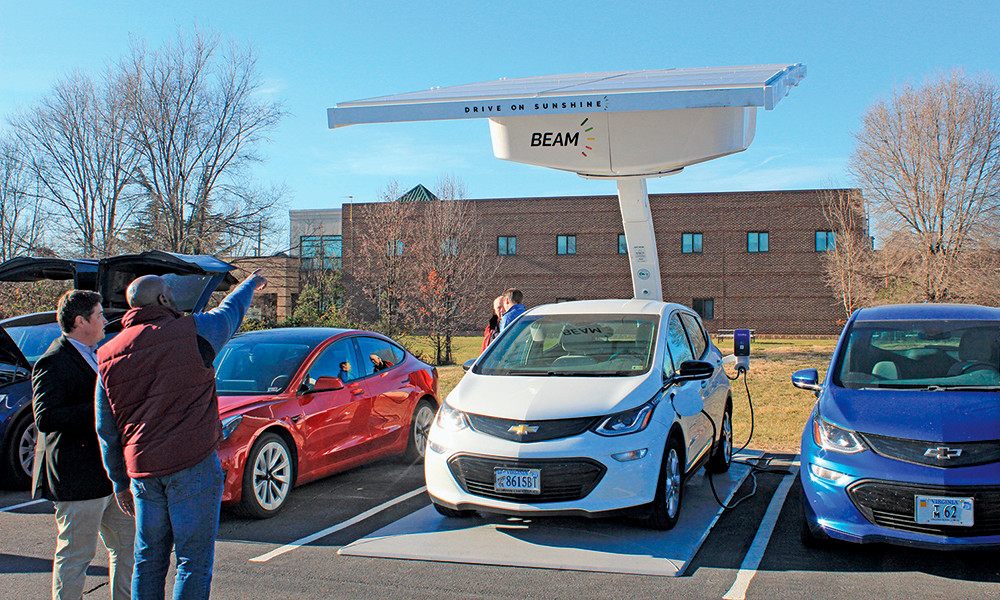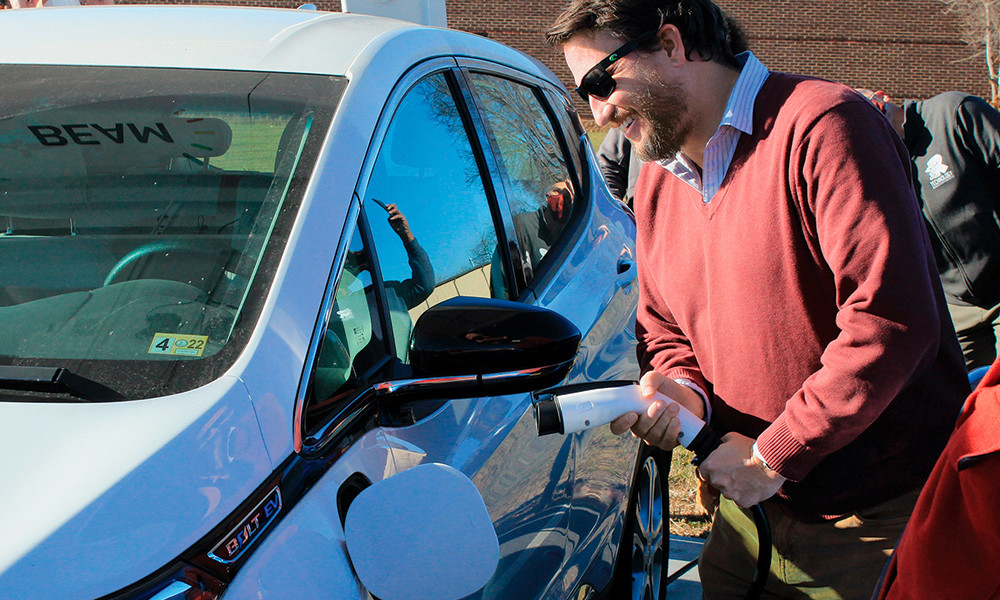JMU partnering with Virginia Clean Cities on clean-transportation initiatives
Featured Stories
SUMMARY: Since 2022, Virginia Clean Cities has secured more than $19 million in external funding to deploy advanced technology vehicles and alternative-fuel infrastructure while conducting education and outreach on the importance of reducing transportation emissions, improving economic opportunities, and strengthening energy-supply chains.
A model university is a steward, not only to the people who make up its community, but also to the region it calls home. With more than a decade of partnership, Virginia Clean Cities and JMU have succeeded in improving air quality and building economic opportunities through various infrastructure- and education-based programs.
Through their collaboration, they hope to transform Harrisonburg-Rockingham County into a region of energy independence. By bringing in federal, state and private grants; sponsoring programs; and building stakeholder networks, VCC is enriching the quality of life for Virginians.
Alleyn Harned (’14M), executive director of VCC, shared several multimillion-dollar initiatives underway.
The Mid-Atlantic Nitrogen Oxide Reduction Project is a JMU-led initiative to help dramatically reduce tailpipe emissions from large, diesel-burning vehicles.

Since 2019, the project has partnered with UPS, successfully replacing numerous diesel-burning vehicles in the delivery company’s fleet with a mix of compressed natural gas and other clean-diesel technologies.
According to its website, MANOR estimates it saves more than 468,000 gallons of diesel fuel per year and reduces emissions by approximately 35%.
|
"Electricity is just part of the puzzle that we are trying to put together.”" — Matthew Wade (’03, ’07M, ’18M), VCC deputy director |
The project’s first phase saw the reduction of vehicles in Virginia, Maryland and Pennsylvania in areas facing persistent air quality problems.
Currently, the MANOR project is in its second iteration, focusing solely on renewable compressed natural gas, which will make an even greater impact on pollution reduction. In Harrisonburg, the project has already helped local transportation-logistics efforts by replacing older diesel trucks with cleaner CNG trucks. VCC has also provided technical assistance to the city in its efforts to electrify multiple school buses.
“The focus of our program is to align with engagement, public service and other key aspects of the university’s mission, and to align educational programs or career-based engagement,” Harned said.
With the help of a grant proposal authored by JMU, another VCC project is underway.
The Mid-Atlantic Electrification Partnership has launched in Virginia, West Virginia, Maryland and Washington, D.C. This initiative has created a regional, electric-vehicle ecosystem through the development of EV ride-sharing vehicles and new charging stations.

VCC Deputy Director Matthew Wade (’03, ’07M, ’18M) said initially the plan was to build 300 Level 2 charging stations in Virginia, Maryland and Washington, D.C., but the program has exceeded that number. “We hit our goal of more than 300 chargers deployed, but that is just one piece of the puzzle, because then we had to build our ride-share system,” Wade said.
As part of the project, partnering utility company Baltimore Gas and Electric purchased 100 electric vehicles and leased them to Lyft drivers in the greater Baltimore area. As of the end of December 2024, more than a million miles had been logged by these EVs. Calculating the carbon emissions from how much gasoline it would take to travel that distance, the ride-share vehicles have prevented almost 800,000 pounds of carbon-dioxide tailpipe emissions, Wade said.
At the local level, Harned said, efforts are being made to electrify the Gus Bus, a mobile classroom serving elementary school students in the area and involving JMU’s Institute for Innovation in Health and Human Services and the College of Health and Behavioral Studies.
|
"The focus of our program is to align with engagement, public service and other key aspects of the university’s mission, and to align educational programs or career-based engagement." — Alleyn Harned (’14M), |
With plans to install a 140-kilowatt traction battery strong enough to power a household, “the ability to run power without being reliant on diesel as it serves the children of the Harrisonburg and greater Rockingham County community is very promising,” Harned said.
JMU is also making waves by piloting solar EV-charging infrastructure, further bringing rural America into the conversation regarding sustainable energy usage.
“You can plug in your car and just charge off sunshine-powered batteries — literally — because it’s not grid-tied at all,” Wade said. “And that’s what we are trying to demonstrate for rural areas or places that are hard to access from utility-grid connections.” JMU students interested in the study of clean transportation have the opportunity to take part in the Last Mile Leadership scholarship program through another VCC project, LODESTAR, in which experts in the field of alternative energy are helping students apply clean transportation to their fields of study.
Harned believes this is the leadership decade. But it is also one that will be defined by experimentation and collaboration.
“The next five years are very specifically aligned with leadership and early-stage energy changes, where people, communities, corporations, governments and individuals seek to reduce their emissions footprint by 50%,” Harned shared.
Virginia communities and companies hope to be at the head of these efforts.
The alternative fuel industry is gaining traction, and VCC, though based in Harrisonburg, is expanding its domain, with offices around the state and impacts beyond the region. The options are ever-expanding with the emergence of renewable propane, renewable diesel, sustainable aviation fuels, and other exciting low- and zero-emission petrochemical innovations.
Twenty years from now, Virginia Clean Cities hopes to see positive changes that benefit livelihoods and pocketbooks, reduce emissions, and present a brighter future for the planet.
“Electricity is just part of the puzzle that we are trying to put together,” Wade said. “Our role is to help people figure out which alternative domestic fuel or technology will make their fleets and their lives more efficient.

